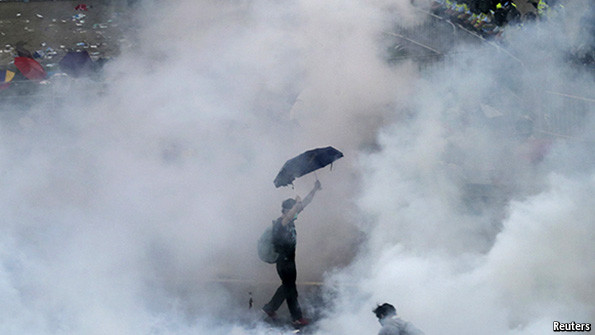IT IS a most unusual sight on Chinese soil, and most unsettling for leaders in Beijing. On September 28th and 29th tens of thousands of demonstrators surrounded government offices and filled major thoroughfares around Hong Kong, braving rounds of tear gas from riot police to call for democracy and demand the resignation of Leung Chun-ying, the territory’s Beijing-backed chief executive. One image broadcast and shared around the world, of a lone protester holding his umbrella aloft in a cloud of tear gas (pictured above), has given the non-violent protests a poetic echo of “tank man” from the crackdown at Tiananmen Square in 1989.

It also captures precisely what Communist Party leaders in Beijing fear from Hong Kong and its special status under the “one country, two systems” arrangement it has enjoyed since the territory’s handover from Britain in 1997. Not only are its people willing (and allowed by law) to challenge their government openly, but they also could become an inspiration for protests elsewhere in China. The spread of news and images of the protests has been blocked or heavily censored on the mainland, but as the protests carry on, the risk of contagion rises. In that sense this marks one of the most difficult tests of Chinese rule since Tiananmen.
Compounding the difficulty is the lack of a middle ground. The protesters’ main demand is that the people of Hong Kong be allowed to vote for any candidate of their choosing in elections for the post of chief executive in 2017 (the first in which citizens would have such a vote). President Xi Jinping has made clear he will have nothing resembling full Western democracy within China’s borders. The current election plan, put forward by the central government on August 31st, gives the central government an effective veto over nominees to ensure that Hong Kong remains firmly under its control.
Several protest movements have converged to challenge that control. Until recently the best-known movement had been Occupy Central with Love and Peace, which is modelled on Occupy Wall Street and named after an important business district at the heart of Hong Kong. But even Occupy’s leaders wondered whether they could muster meaningful numbers.
The biggest drivers of these protests have been university students and secondary school students, thousands of whom boycotted classes last week. On the evening of September 26th the leader of the secondary school students, 17-year-old Joshua Wong of Scholarism, was arrested—a move that, along with the use of pepper spray by police, was credited with swelling the popularity of the protests over the weekend (Mr Wong was released on Sunday). In the early hours of September 28th Benny Tai, one of the leaders of Occupy Central, announced that its protest, which had been scheduled for October 1st, China’s national day holiday, would begin immediately.
Mr Leung has shown no sign of bending. On the afternoon of September 28th, at a press conference held inside the government headquarters while thousands of protesters surrounded the building, Mr Leung repeated his endorsement of the election plan. It calls for chief executive candidates to be screened by a committee stacked with Communist Party supporters (he was elected by a similar committee in 2012, collecting 689 votes along with the derisive nickname “689”). Mr Leung acknowledged that the plan may not have been the “ideal” that some wanted, but he called it progress nonetheless. He said it had given Hong Kong citizens the “universal suffrage” they had been promised. Mr Leung said he welcomed “rational” dialogue but that the government would be “resolute” in dealing with the “unlawful” demonstrations. Asked whether the Chinese army would ever be used, Mr Leung expressed his confidence in the police. The tear gas canisters began flying shortly afterward, surprising protesters who exclaimed variations of “are you kidding?” and “shame on you”. Many donned goggles and unfurled umbrellas to protect themselves against the gas, while some raised their hands and yelled, “don’t shoot”. The protests did not become violent, but they grew and spread to other areas. The calls for Mr Leung’s resignation became louder.
via Hong Kong’s protests: A tough test for China’s leaders | The Economist.
























